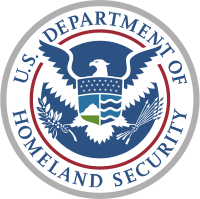United States Secret Service
| United States Secret Service | |
| Common name | Secret Service |
| Abbreviation | USSS |
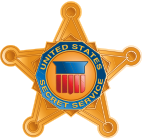 |
|
| USSS star logo | |
| Agency overview | |
|---|---|
| Annual budget | $1.483 billion (FY2010)[1] |
| Legal personality | Governmental: Government agency |
| Jurisdictional structure | |
| Federal agency | USA |
| General nature |
|
| Specialist jurisdiction | |
| Operational structure | |
| Sworn members | 4,400 |
| Agency executive | Mark J. Sullivan, Director |
| Parent agency | United States Department of Homeland Security |
| Field Offices | 136 |
| Facilities | |
| Resident Agent Offices | 68 |
| Overseas Offices | 19 |
| Website | |
| http://www.SecretService.gov | |
The United States Secret Service is a United States federal law enforcement agency that is part of the United States Department of Homeland Security.[2] The sworn members are divided among the Special Agents and the Uniformed Division. Until March 1, 2003, the Service was part of the United States Department of Treasury.[3]
The US Secret Service has two distinct areas of responsibility:
- Treasury roles, covering missions such as prevention and investigation of counterfeiting of US currency and US treasury bonds notes and investigation of major fraud.[4]
- Protective roles, ensuring the safety of current and former national leaders and their families, such as the President, past Presidents, Vice Presidents, presidential candidates, foreign embassies (per an agreement with the US State Department's Bureau of Diplomatic Security (DS) Office of Foreign Missions (OFM)), etc.[5]
The Secret Service's initial responsibility was to investigate crimes related to the Treasury and then evolved into the United States' first domestic intelligence and counterintelligence agency. Many of the agency's missions were later taken over by subsequent agencies such as the FBI, ATF, and IRS.
Contents |
Roles
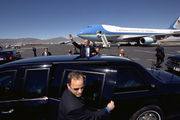
Today the agency's primary investigative mission is to safeguard the payment and financial systems of the United States. These include crimes that involve financial institution fraud, computer and telecommunications fraud, false identification documents, access device fraud, advance fee fraud, electronic funds transfers and money laundering as it relates to the agency's core violations. However, after the 1901 assassination of President William McKinley, Congress directed the Secret Service to protect the President of the United States. Protection remains a key mission of the United States Secret Service.
Today, the Secret Service is authorized by law to protect:
- The President, the Vice President, the President-elect and Vice President-elect
- The immediate families of the above individuals
- Former Presidents and their spouses for their lifetimes except when the spouse remarries. In 1997, legislation became effective limiting Secret Service protection to former Presidents for a period of not more than 10 years from the date the former President leaves office
- Children of former Presidents until age 16 or 5 years after the presidency
- Former Vice Presidents until 6 months after their term ends: (the Secretary of Homeland Security can extend the protection time.)
- Families of former Vice Presidents until 6 months after term ends
- Visiting heads of states or governments and their spouses traveling with them, other distinguished foreign visitors to the United States, and official representatives of the United States performing special missions abroad whom the president deems important enough for protection outside the Diplomatic Security Service
- Major presidential and vice presidential candidates, and their spouses within 120 days of a general presidential election
- Other individuals as designated per executive order of the President
- National Special Security Events, when designated as such by the Secretary of Homeland Security
- In 2009 the Secret Service began protecting the Secretary of State, however that is only because Hillary Clinton merits it as a former First Lady. Future Secretaries will again be protected by the Diplomatic Security Service as the DSS falls under the Department of State.
The Secret Service investigates thousands of incidents a year of individuals threatening the President of the United States.
Uniformed Division
The United States Secret Service Uniformed Division (UD) assists in protection duties. Established in 1922 as the White House Police Force, this organization was fully integrated into the Secret Service in 1930. With more than 1,300 officers as of 2010, the Uniformed Division is responsible for security at the White House Complex; the vice president's residence; the Department of the Treasury (as part of the White House Complex); and foreign diplomatic missions in the Washington, D.C., area. Uniformed Division officers carry out their protective responsibilities through a network of fixed security posts, foot, bicycle, vehicular and motorcycle patrols.
Officers are responsible for providing additional support to the Secret Service's protective mission through the following special support programs:
The Countersniper Support Unit (CS): Created in 1971, the CS unit's purpose is to provide specialized protective support to defend against long-range threats to Secret Service protectees. Today CS is an operational element of the Presidential Protective Division.[6]
The Canine Explosives Detection Unit (K-9): Created in 1976, the mission of the K-9 unit is to provide skilled and specialized explosives detection support to protective efforts involving Secret Service protectees.[6]
The Emergency Response Team (ERT): Formed in 1992, ERT's primary mission is to provide tactical response to unlawful intrusions and other protective challenges related to the White House and its grounds. ERT personnel receive specialized, advanced training and must maintain a high level of physical and operational proficiency.[6]
Magnetometers: The Secret Service began relying on magnetometer (metal detector) support by Uniformed Division officers to augment its protective efforts away from the White House following the attempted assassination of President Ronald Reagan. The Magnetometer Support Unit's mission is to ensure that all persons entering secure areas occupied by Secret Service protectees are unarmed.[6]
Attire
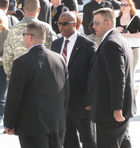
Special Agents of the Secret Service wear attire that is appropriate for the surroundings. In many circumstances, the attire is a conservative suit, but attire can range from a tuxedo to blue jeans. Photographs often show them wearing sunglasses and a communication earpiece. They also wear lapel pins of a color and shape that, for security purposes, varies regularly, but each design prominently features the service's star emblem in the center. These lapel pins are usually changed hourly when agents travel with the President. Secret Service agents are barred from buttoning their suit coats or jackets as they need to be able to access their firearm quickly if the need arises. The attire for Uniformed Division Officers includes standard police uniforms or utility uniforms and ballistic/identification vests for members of the countersniper team, Emergency Response Team (ERT), and canine officers.
The shoulder patch of the Uniformed Division consists of the presidential seal on white or black depending on the garment to which it is attached. While there is no official patch indicating "Secret Service", Special Agents have occasionally designed and purchased unofficial patches to trade in their extensive collaborations with uniformed law enforcement officers.[7]
History
Early years
With a reported one third of the currency in circulation being counterfeit[8], the Secret Service was created by President Abraham Lincoln on April 14, 1865 (five days after the formal end of the American Civil War), and commissioned on July 5, 1865, in Washington, D.C. as the "Secret Service Division" of the Department of the Treasury with the mission of suppressing counterfeiting. The legislation creating the agency was on Abraham Lincoln's desk the night he was assassinated.[9] At the time, the only other federal law enforcement agencies were the United States Park Police, U.S. Post Office Department, Office of Instructions and Mail Depredations, now known as the United States Postal Inspection Service, and the United States Marshals Service. The Marshals did not have the manpower to investigate all crime under federal jurisdiction, so the Secret Service began to investigate everything from murder to bank robbery to illegal gambling. After the assassination of President William McKinley in 1901, Congress informally requested that the Secret Service provide presidential protection. A year later, the Secret Service assumed full-time responsibility for presidential protection. In 1902, William Craig became the first Secret Service agent to be killed while riding in the presidential carriage, in a road accident.
Secret Service was the first U.S. domestic intelligence and counterintelligence agency. Domestic intelligence collection and counterintelligence responsibilities were vested in the Federal Bureau of Investigation (FBI) after the FBI's creation in 1908. The Secret Service assisted in arresting Japanese American leaders and in the Japanese American internment during World War II.[10] The U.S. Secret Service is not an official part of the U.S. Intelligence Community.[11]
Truman assassination attempt
In 1950, President Harry S. Truman was residing in Blair House, across the street from the White House, while the executive mansion was undergoing renovations. Two Puerto Rican nationalists, Oscar Collazo and Griselio Torresola, approached Blair House with the intent to assassinate President Truman. Collazo and Torresola opened fire on Private Leslie Coffelt and other White House Police officers. Though mortally wounded by three shots from a 9 mm Luger to his chest and abdomen, Private Coffelt returned fire, killing Torresola with a single shot to his head. As of 2010[update], Coffelt is the only member of the Secret Service to be killed while protecting a US President against an assassination attempt (Special Agent Tim McCarthy stepped in front of President Ronald Reagan during the assassination attempt of March 30, 1981 and took a bullet to the abdomen but made a full recovery). Collazo was also shot but survived his injuries and served 29 years in prison before returning to Puerto Rico in 1979.
1960s to 1990s
In 1968, as a result of presidential candidate Robert F. Kennedy's assassination, Congress authorized protection of major presidential and vice presidential candidates and nominees (Pub.L. 90-331). In 1965 and 1968, Congress also authorized lifetime protection of the spouses of deceased presidents unless they remarry and of the children of former presidents until age 16.[3]
Congress passed legislation in 1994 stating that presidents who enter office after January 1, 1997 receive Secret Service protection for 10 years after leaving office. Presidents who entered office prior to January 1, 1997 will continue to receive lifetime protection (Treasury Department Appropriations Act, 1995: Pub.L. 103-329).
Changing roles
The Secret Service Presidential Protective Detail safeguards the President of the United States and his immediate family. They work with other federal, state and local law enforcement agencies and the military to safeguard the President when he travels in Air Force One, Marine One, and by limousine in motorcades.
Although the most visible role of the Secret Service today, personal protection is an anomaly in the responsibilities of an agency focused on fraud and counterfeiting. The reason for this combination of duties is that when the need for presidential protection became apparent in the early 20th century, few federal services had the necessary abilities and resources. The FBI, IRS, ATF, ICE, and DEA did not yet exist. The United States Marshals Service was the only other logical choice, providing protection for the President on a number of occasions.
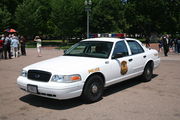
As of 2010, the Service has over 6,500 employees: 3,200 Special Agents, 1,300 Uniformed Division Officers, and 2,000 technical and administrative employees.[12] Special agents serve on protective details, special teams or sometimes investigate certain financial and homeland security-related crimes.
The Uniformed Division is similar to the United States Capitol Police and is in charge of protecting the physical White House grounds and foreign diplomatic missions in the Washington, D.C. area. The Uniformed Division was originally a separate organization known as the White House Police Force, but was moved into the Secret Service in 1930. In 1970, the role of the force, then called the Executive Protective Service, was expanded. The name United States Secret Service Uniformed Division was adopted in 1977.
While primarily responsible for presidential protection, the Secret Service may also investigate forgery of government checks, forgery of currency equivalents (such as travelers' or cashiers' checks), and certain instances of wire fraud (such as the so-called Nigerian scam) and credit card fraud.
The Secret Service has concurrent jurisdiction with the FBI over certain violations of federal computer crime laws. They have created 24 Electronic Crimes Task Forces (ECTFs) across the United States. These task forces are partnerships between the Service, federal/state and local law enforcement, the private sector and academia aimed at combating technology-based crimes.
In 1998, President Bill Clinton signed Presidential Decision Directive 62, which established National Special Security Events (NSSE). That directive made the Secret Service responsible for security at designated events.
Effective March 1, 2003, the Secret Service transferred from the Treasury to the newly established Department of Homeland Security.
Attacks on Presidents
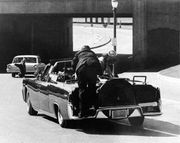
Since the 1960s, Presidents John F. Kennedy (killed), Gerald Ford (twice-attacked, but uninjured) and Ronald Reagan (seriously injured) have been attacked while appearing in public.[13][14] Agents on scene though not injured during attacks on Presidents include William Greer, and Roy Kellerman. One of the more distinguished agents was Robert DeProspero, the Special Agent In Charge (SAIC) of Reagan's Presidential Protective Division (PPD) from January 1982 to April 1985. DeProspero was deputy to Jerry S. Parr, the SAIC of PPD during the Reagan assassination attempt on March 30, 1981.[15][16]
The Kennedy assassination spotlighted the bravery of two Secret Service agents. First, an agent protecting Mrs. Kennedy, Clint Hill, was riding in the car directly behind the Presidential limousine when the attack began. While the shooting continued, Hill leapt from the running board of the car he was riding on and jumped on to the back of the President's moving car and guided Mrs. Kennedy from the trunk back into the rear seat of the car. He then shielded the President and the First Lady with his body until the car arrived at the hospital.
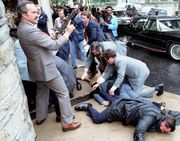
Rufus Youngblood was riding in the Vice-Presidential car. When the shots were fired, he vaulted over the front seat and threw his body over Vice President Lyndon B. Johnson. Youngblood would later recall some of this in his memoir, Twenty Years in the Secret Service. That evening, Johnson called Secret Service Chief James J. Rowley and cited Youngblood's bravery.[17]
The period following the Kennedy assassination was the most difficult in the modern history of the agency. Press reports indicated that morale among the agents was "low" for months following the assassination.[18] The agency overhauled its procedures in the wake of the Kennedy killing. Training, which until that time had been confined largely to "on-the-job" efforts, was systematized and regularized.
The Reagan assassination attempt also highlighted the bravery of several Secret Service agents, particularly agent Tim McCarthy, who spread his stance to protect Reagan as six bullets were being fired by the would-be assassin, John Hinckley, Jr.[19] McCarthy survived .22-caliber round in the abdomen. For his bravery, McCarthy received the NCAA Award of Valor in 1982.[20] After the near-successful assassination attempt of Ronald Reagan, it was very clear that the Secret Service needed to increase its efficiency to protect the President.
September 11, 2001 attacks
The New York City Field office was located at 7 World Trade Center. Immediately after the attacks, Special Agents and other New York Field office employees were among the first to respond with first aid. Sixty-seven Special Agents in New York City, at and near the New York Field Office, helped to set up triage areas and evacuate the towers. One Secret Service employee, Master Special Officer Craig Miller,[21] died during the rescue efforts. On August 20, 2002, Director Brian L. Stafford awarded the Director's Valor Award to employees who assisted in the rescue attempts.
Former Presidents and First Ladies
In 1965, Congress authorized the Secret Service (Public Law 89-186)[22] to protect former presidents and spouses during their lifetimes. In 1994, Congress limited this protection to ten years after leaving office. Individuals who were in office before January 1, 1997 continue to receive Secret Service protection for their lifetime. Therefore, Bill Clinton is the last president to receive lifetime protection.
Training and weaponry
At a minimum, a prospective agent must be a U.S. Citizen, possess a current valid driver's license, possess visual acuity no worse than 20/60 uncorrected, correctable to 20/20 in each eye and be between the ages of 21 and less than 37 at the time of appointment. However, preference eligible veterans may apply after age 37. In 2009, the Office of Personnel Management issued implementation guidance on the Isabella v. Department of State court decision: OPM Letter [1]

The agency (particularly agents under the Office of Protective Operations) receive the latest weapons, training, and technology. The United States military must fully comply with requests for assistance with protectees, providing equipment, and even military personnel at no cost to the Secret Service.
The Uniformed Division has three branches: the White House Branch, Foreign Missions, and the Naval Observatory Branch. Together they provide protection for the following: The President, Vice President, and their immediate families, presidential candidates, the White House Complex, the Vice President's Residence, the main Treasury Department building and its annex facility, and foreign diplomatic missions in the Washington, D.C. metropolitan area.[23]
As of 2009, Special Agents and Uniformed Division Officers carry the SIG Sauer P229 pistol chambered for the .357 SIG cartridge,[24] and the FN Five-seven pistol chambered for the 5.7x28mm cartridge.[25] Agents are also trained on close-combat weapons such as the Remington 870 shotgun, the FN P90 submachine gun, and the HK MP5.[24] They have radios and surveillance kits in order to maintain communication.[26] During the presidential visits of Bill Clinton and George W. Bush to Australia, the Secret Service caused controversy for carrying concealed firearms in violation of Australian law, which requires that all firearms be worn visibly.
Directors
|
|
Field offices
The Secret Service has agents assigned to 136 field offices and the headquarters in Washington, D.C. while the field offices are located in cities throughout the United States and in Brazil (Brasilia), Bulgaria (Sofia), Canada (Montreal, Ottawa, Toronto, Vancouver), Colombia (Bogota), China (Hong Kong), France (Paris), INTERPOL, Germany (Frankfurt), Italy (Rome), Mexico (Mexico City), EUROPOL (Netherlands/The Hague), Romania (Bucharest), Russia (Moscow), South Africa (Pretoria), Spain (Madrid), Thailand (Bangkok), and the United Kingdom (London).
In popular culture
- Guarding Tess - Film, Nicolas Cage played an agent assigned to guard a former First Lady.
- In the Line of Fire - Film about a presidential assassination plot starring Clint Eastwood.
- The Sentinel (2006 film) - Michael Douglas played a USSS agent under suspicion of being a traitor.
- To Live and Die in L.A. - Film about a Secret Service agent (William L. Petersen) determined to bring down a counterfeiter (Willem Dafoe) by any means necessary.
- Air Force One - Action film starring Harrison Ford. A group of terrorists hijack Air Force One and hold the president's family and staff hostage. A Secret Service agent is revealed to be a traitor working with the terrorists.
- The West Wing TV show about life in the White House. Jorja Fox played an agent assigned to protect the president's daughter. In Season 3, Mark Harmon played Agent Simon Donovan, assigned to protect Press Secretary CJ Cregg.
- Warehouse 13 A new Syfy series about two Secret Service agents who are taken from their old job of guarding the President and instead are sent to track down artifacts with supernatural powers.
- 24 Involves many characters and operations within the Secret Service as they protect the Presidents throughout the series.
Similar organizations
- DSS - U.S. Diplomatic Security Service, Department of State
- Immigration and Customs Enforcement (ICE)
- List of protective service agencies
- United States Federal Protective Service
See also
- Armour
- Ballistic vest
- Bodyguard
- Commander-in-Chief's Guard — The American Revolutionary War unit that also had the dual responsibilities of protecting the Commander-in-Chief and the Continental Army's money.
- Imperial Guards
- List of United States federal law enforcement agencies
- Praetorian Guard
- Secret Service codename
- SO14 & SO16
- Special Detective Unit - Garda Síochána
- VIP Protection Unit
Notes
- ↑ Reese, Shawn (December 16, 2009), The U.S. Secret Service: An Examination and Analysis of Its Evolving Missions, Congressional Research Service, http://www.fas.org/sgp/crs/homesec/RL34603.pdf
- ↑ "The U.S. Secret Service: An Examination and Analysis of Its Evolving Missions". Congressional Research Service. 2008-07-31. http://www.fas.org/sgp/crs/homesec/RL34603.pdf. Retrieved 2008-09-08.
- ↑ 3.0 3.1 "Secret Service History". United States Secret Service. http://www.secretservice.gov/history.shtml. Retrieved 2008-03-09.
- ↑ http://www.secretservice.gov/investigations.shtml
- ↑ SecretService.gov
- ↑ 6.0 6.1 6.2 6.3 http://www.secretservice.gov/whoweare_ud.shtml
- ↑ The American Presidency
- ↑ http://clinton2.nara.gov/WH/kids/inside/html/spring98-2.html
- ↑ Petro, Joeseph; Jeffery Robinson (2005). Standing Next to History, An Agent's Life Inside the Secret Service. New York: St. Martin's Press. pp. 16. ISBN 0312332211.
- ↑ 11 Asian L.J. 147 (2004), Foreword: Sixty Years after the Internment: Civil Rights, Identity Politics, and Racial Profiling; Tamaki, Donald K.
- ↑ Intelligence.gov
- ↑ SecretService.gov
- ↑ Secret Service told grenade landed near Bush
- ↑ "Bush grenade attacker gets life". CNN. 2006-01-11. http://www.cnn.com/2006/WORLD/europe/01/11/georgia.grenade/index.html. Retrieved 2007-01-03.
- ↑ Petro, Joeseph; Jeffery Robinson (2005). Standing Next to History, An Agent's Life Inside the Secret Service. New York: St. Martin's Press. pp. 140–141 & 202–204. ISBN 0312332211.
- ↑ WVU Alumni | Robert L. DeProspero
- ↑ "The Transfer of Power", Time magazine, November 29, 1963.
- ↑ Twenty Years in the Secret Service by Rufus Youngblood, pages 147–149. Vince Palamara interviews with former agent Rufus Youngblood on 10/22/92 and 2/8/94—please see: Survivor's Guilt: The Secret Service and the Failure to Protect the President.
- ↑ He Took A Bullet For Reagan "'In the Secret Service,' [McCarthy] continued, 'we're trained to cover and evacuate the president. And to cover the president, you have to get as large as you can, rather than hitting the deck.'"
- ↑ By means of the NCAA Award of Valor, the National Collegiate Athletic Association recognizes "courageous action or noteworthy bravery" by persons involved with intercollegiate athletics. McCarthy had played NCAA football at the University of Illinois.
- ↑ Master Special Officer Craig J. Miller, United States Department of the Treasury - Secret Service Special Services Division
- ↑ Secret Service Frequently Asked Questions.
- ↑ "Uniformed Division". US Secret Service. http://www.secretservice.gov/whoweare_ud.shtml. Retrieved 19 March 2010.
- ↑ 24.0 24.1 "A Stability Police Force for the United States: Justification and Options for Creating U.S. Capabilities". http://rand.org — RAND Research Corporation. 2009. http://www.rand.org/pubs/monographs/2009/RAND_MG819.pdf. Retrieved 2010-04-05.
- ↑ Jones, Richard D. Jane's Infantry Weapons 2009/2010. Jane's Information Group; 35 edition (January 27, 2009). ISBN 978-0710628695.
- ↑ Eyeballing the US Secret Service Technical Security Division
External links
- United States Secret Service website
- Protecting the US President abroad
- USSS and Italian law enforcement agencies protecting President George W. Bush in Rome (April 7, 2005)
- Press release concerning rescue Efforts of USSS NY Field Office immediately after the World Trade Center Attacks
- Inside the Secret Service - slideshow by Life magazine
|
||||||||||||||||||||||||||||||
